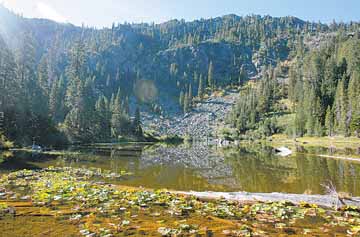|
Disappearing into the autumn wilderness
 |
|
The lake pictured above has no name in the USGS system of grid maps created in 2005. According to the book, "100 Hikes in Southern Oregon," by William L Sullivan, the body of water is known as "Private Lake" and is in the Siskiyou Wilderness of Northern California. |
Some mornings you wake up and just need to disappear into the wilderness. A good place to make that happen is the northern edge of the Siskiyou Wilderness, near a lake without a name and a valley without a trail. Here’s video of the area and a photo gallery.By Zach Urness of the Daily CourierYou awake to electric bursts of alarm clock noise, roll out of bed, and in the 6 a.m. darkness of your kitchen, brew a pot of thick black coffee.You haven't turned the lights on in your house yet and don't plan to. Everything you need is already in the truck, thrown together the night before in your 1974 Skyline backpack. With a mug of coffee in hand, you drive south of Grants Pass, watching as the buildings become pine trees and the names of the roads go from Redwood to Waldo to Takilma. Soon the roads have no names at all — are identified by a sequence of numbers logical only to the Forest Service — and overgrown tree branches scratch against the windows as you rumble up into the mountains. After 12 miles, you drive into the shadow of a massive black thumb of rock towering above the dirt road and know you've reached Black Butte Trailhead — a path that crosses the Oregon/California border through the Siskiyou Wilderness. The morning is clear and cool as you step outside the truck. A line of slow October sunlight inches across the bare stone ridges, illuminating the landscape's peaks and valleys by incremental degrees. The pack feels strangely light, mostly because you've elected not to bring a tent, and instead intend to spend the night under the stars. The first section of the trail shoots upward about two miles to Polar Bear Gap — a U-shaped gateway sliced between two mountains that leads to more remote land. After crossing over the pass, you hike downhill on a trail of loose rock that becomes more and more faint. Soon the trail gives out completely, disappearing into piles of dead leaves and timber. For a moment you stop, unsure of what to do next. Finally you see an unnatural stack of rocks sticking up among the brush and walk toward it. The rocks are blueish-green with flecks of silver and are stacked in a crude pyramid shape. You look up and see another pyramid stack of rocks 25 yards away. For almost half a mile you follow the network of rock pyramids, until you reach a small creek at the head of a long, thin valley. The valley is surrounded by the high, thick walls of the mountains. The meadow is golden brown in the sun, and along the creek are trees with cinnamon red and orange leaves. You take off your pack, set it against a rock near the creek and dip your bottle into the running water. After a cold drink, you ball your sweater up into a pillow and lay down below a large tree. The sun streams through the web of branches. You smell the leaves and dry wood, put your hands behind your head and shut your eyes. o o o You awake to a body that's sweaty and sore. And for a moment, you're not entirely sure where you are. Consciousness comes slowly, but once you're done blinking the sharp sunlight from your eyes, you know it's time to get moving. You walk down the middle of the upper valley, through a patch of woods, and into a lower valley before finding a trail that turns southwest and shoots uphill with a vengeance. You hike up the steep, rocky trail, sweating in the sun. Your head feels heavy with sleep and you're sore and tired. The first part of the hike was easy. Now the trail is burning your legs and the sun is baking your neck. For the next three miles the trail slopes up-and-down through a forest of Shasta red fir and Port Orford cedar. Tiny lizards lay sunning themselves on the rocks as you pass marshes and meadows. Eventually, you come across another stacked rock pyramid that marks a trail to the cirque of a Siskiyou Mountain lake. The lake is small and shallow, with a few lily pads along the edges. Along the shoreline are tall, dry trees. Above the trees are two brown, saw-tooth peaks called the Lieutenants. The mountains are 6,205-feet high and seem to hang out over the water, as though peering down on the puddle covering its feet. The lake itself has no name, which seems strange. Almost every detail of land you've seen today has a name. Black Butte trail. Twin Valley. Polar Bear Gap. Yet the lake you look upon remains anonymous on the USGS topographic map. As the night becomes darker and stars begin to populate the sky, you take out your sleeping roll and smooth out a flat place on the dirt. Sleeping under the stars isn't something you normally do, but you've done it enough that it's familiar — you no longer bolt upright to every sound in the dark. You keep a fire going with small, dead pieces of pine, and use the flames to warm your dinner of beef stew, augmented by tortillas and canned peaches. The moon is high and bright now above the cliffs. You douse the flames of the fire, climb into your sleeping bag and look out at the unnamed lake, shimmering like a disc of polished metal in the emptiness of the night.
| 




